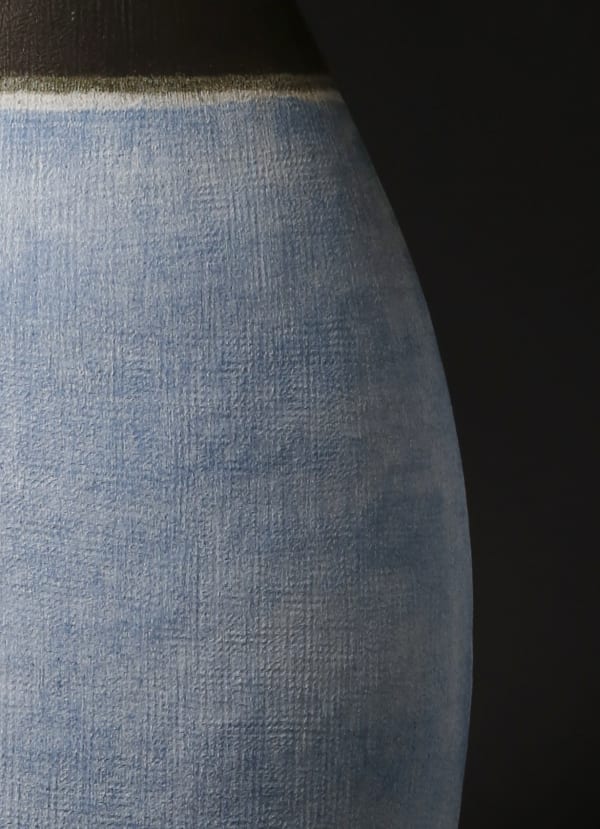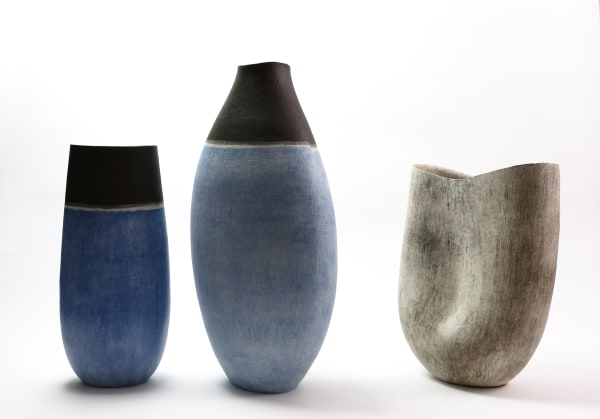Earth From Sky : Stoneware Works By Mitsukuni Misaki
Beginning to Breathe
Shoko Aono
Blue oceans, endless skies, billowing clouds — a boundless world with a horizon separating earth from sky. Misaki’s works create an impression of limitless space and time, like an ever-expanding universe. Their slightly distorted forms are evocative of naturally sprouting seeds or fruit. Perhaps they remind us the mother’s womb that enveloped us so long ago. If we touch them, it is as if we can feel a pulse. Looked at in this way, we realize that Misaki’s works are both nostalgic and quiet, becoming life forms in their own right.
When he was young, Misaki planned to study law but when he entered university student radicalism was at its peak making it difficult for him to attend lectures. Contemplating on the meaning of life, he set off on a wandering journey, then in 1972, when he was 21 years old, he met the world-famous scholar of porcelain and pottery, Fujio Koyama (1900–1975). As an empirical researcher, Koyama had written numerous books on old pottery and in his latter years he built his own kiln, named hananoki, where he produced his own pots. As a result of this meeting, Misaki decided to devote himself to becoming a potter.
Living amidst the rapid changes of contemporary society, Misaki felt that he ‘wanted to live in a stationary time’, and pursue the images that rose naturally in his mind. He describes this condition as “rothkoing”, describing this as a state resembling the light emitted by colors in Mark Rothko’s paintings.
He does not use a wheel, preferring to build up his forms by hand, imbuing the surface with a feeling of tension while producing works that seem almost weightless. The color is produced by using four layers of blue and white slip that he rubs into the surface of the clay. These are then fired at high temperature to produce huge, stoneware pots, that sometimes appear to resemble ships that will carry us away into vast distances.
This is Misaki’s first solo exhibition outside of Japan. It will be interesting to see how Misaki’s “life forms” will begin to breathe here in New York, where every shade of color is jumbled together and moves ahead at high speed. This is something to look forward to.
Ippodo Gallery is pleased to present the first solo showcase of ceramic artist Mitsukuni Misaki (b.1951) outside Japan. The poetry of form is paired with the artist’s urge to create powerful, lifelike works, encapsulating the dual strength and subtlety of beauty in nature. 15 works on view project this unnameable sensation, with asymmetrical works conveying the desire for serenity.
The essence Misaki aims to express comes from a restlessness in his soul. Curiosity is pervasive throughout his work, and endures as a part of the artist’s nomadic experience. From his earliest years of travel in the 1970s, Misaki eschewed what may have amounted to a successful career in law during a period of revolt in academia. Instead, inspired by world-famous potter and scholar Fujio Koyama (1900–1975), Misaki decided to devote himself to an artistic career. He thus traveled to many studios, drawing inspiration from the sky, the ocean, and the boundlessness he continues to seek today.
As he wrote in one of his letters, the quest for meaning is very significant. “Wandering allowed me to indulge myself in the pain and sweetness of walking in the wind and rain,” he writes, rhythmic and pensive.
The works are referred to as Saiyuudeiki, noted by the Japan Ceramic Society Director Koichi Mori for a well-balanced, ample form. Saiyuudeiki loosely translates to ‘colored stoneware vessels,’’ with Sai 彩 as color, Yuu 釉 as glaze, Dei 泥 as clay and Ki 器 as vessel. The style stands in marked contrast to Bian-hu, a sleeker, flatter part of his cannon.
Deliberate and powerful expression is evidenced in the blue and black horizons of the stoneware, separating earth from sky. The imperfect lines are intentional, derived from sprouting seeds, or the fertile womb of a woman.
In pursuit of form and color, discriminating attention to detail takes shape with what Misaki calls Rothko-ing. Undoubtedly, the divisive aesthetic of blue versus grey bears reference to Mark Rothko’s iconic abstract expressionist works, not only with the two-tone structure, but also with the richness and gradations of the blue. Yet the artist also finds solace in the meditation of Rothko-ing, stripping down to an inactivity that frees his sense of expression. In the detachment from material meaning, spontaneity is revealed.
Misaki hand-crafts the shapes, embracing the tension of touch instead of the more common wheel. He makes large works, with one work as large as 24 x 16 in (61.5 x 41.2 cm)challenges conceptions of space with largess.
The dichotomy of the colors is also crucial, evoking the sense of tension in the quest for bliss. The blue is rubbed and refired using four layers of slip, infusing the pale blue glaze with a middle layer of white for depth, then coated with earthen tones to give the color an appearance of age.
Despite Misaki’s many accomplishments, he remains reclusive on his creative quest. He has exhibited extensively in Japan and received numerous awards, ranging from the Japan Kogei Association Prize in 1989 to the 1993 Grand Prix/Chichibunomiya Trophy at the 12th Japan Ceramic Art Exhibition, all the way to the Grand Prix at the Kikuchi Biennale in 2013. Yet he is atypical of the outward-facing artist, instead seeking solace in his meditative moments alone, apart from time and society. While this creative process has been the result of much fanfare in Japan, time will tell how it manifests in New York.












